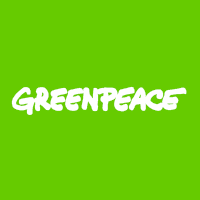Human Cost Of World Bank Investment Exposed: Greenpeace Calls For Environmental Restoration And Clean Production
India/Amsterdam – 19 October 2000: Greenpeace condemned the World Bank and other international agencies (1) today for pushing developing countries to the brink of environmental disaster by investing in polluting industries and Common Effluent Treatment Plants (CETPs) in regions whose environmental standards are weak or non existent. This morning, over 60 Greenpeace activists from 15 countries occupied the pumping station of a CETP that discharges toxic waste from the Vapi Industrial Estate into the Damanganga River, part of the industrial ‘Golden Corridor’ in the Western Indian state of Gujarat. Another four activists chained themselves to the valves controlling the discharge of the poisonous waste water.
The activists were joined by more than 100 people from communities living in the ‘Golden Corridor’, a 170 km stretch of land that houses 17 major industrial estates. Their health and livelihoods have been affected by environmental contamination from polluting industries the region.
“The environmental degradation and neglect in this area is appalling. Every day you can see children of migrant workers and nomads living and playing on the hundreds of illegal toxic waste dumps that dot the landscape. The groundwater is severely contaminated and the streams and rivers run foamy red,” said Greenpeace toxic campaigner, Nityanand Jayaraman.
The CETP on the Vapi Industrial Estate was promoted by the Gujarat Government and the World Bank as a solution to Gujarat's industrial pollution problem. "This effluent treatment plant is a farce. It spews out disgusting water into our river and we believe that the poisons in the waste water are the reason behind our declining fish stocks and health problems," said Devjibhai Tandel, an ex-member of the Indian parliament who lives in a fishing community downstream of the CETP. "We're tired of the Government ignoring our protests that we're being poisoned; that our livelihoods are being destroyed. Investors should first repair the damage done by their past mistakes, rather than add to the problem," he added.
Rather than clean up after its past mistakes, Gujarat has launched an ambitious and ill considered programme to attract about $12 billion in the chemical sector alone. A matching amount is also being sought from agencies, such as the World Bank and Asian Development Bank, to expand the supporting infrastructure sector including superhighways, ports and power projects. The World Bank president, James Wolfensohn, is scheduled to visit the Gujarat Chief Minister, Mr, Keshubai Patel, in mid-November to finalise a loan package for infrastructure development in the state.
A Greenpeace scientific study conducted in 1999 (3) found that the treated waste water from the Vapi CETP was discharging dangerous quantities of poisons, including toxic metals such as lead, cadmium, chromium, copper and even mercury and highly poisonous hexachlorobenzene (HCB). Further tests on the treated wastewater and sediments undertaken this month confirmed that the CETP continues to discharge dangerous levels of poisonous heavy metals, including mercury, into the Damanganga River.
Greenpeace is urging international lending agencies, including the World Bank, to stop all further investments in polluting industries and related infrastructure projects in Gujarat and to invest in the development of clean technologies, remediation and compensation to local communities instead.
"Gujarat is an industrial catastrophe and unplanned investments in polluting industries and related infrastructure is the cause. End-of-pipe interventions such as Common Effluent Treatment Plants actually hinder any attempts to move towards Clean Production," said Jayaraman. "It is ironic that agencies like the World Bank are promoting CETPs rather than cleaning up the mess left behind by their past investments in similar technologies," he added.
Photos of today’s action and of people living amongst the visible environmental contamination in the Gujarat region, India, are available from the Greenpeace International picture desk ( + 31 20 524 9580) on request. For more information and stories from local people, contact http://www.greenpeaceindia.org or, for interviews, call: Shailendra Yashwant, Media Coordinator, Greenpeace India on Mobile - + 91 98 201 82304 Nityanand Jayaraman, Greenpeace toxics campaigner on Mobile - + 91 98 201 94022 Matilda Bradshaw, Media Officer, Greenpeace International on + 31 20 524 9545
end
For information on Greenpeace please visit:
http://www.greenpeace.org
High-bandwidth users can view current and archive streaming Greenpeace videos at:
http://www.tappedintogreenpeace.org
To unsubscribe from this mailing list please visit: http://www.greenpeace.org/interact.shtml Take the link to:"leave mailing list" -----------
For more information on this press release please contact: Greenpeace International Press Office T: ++ 31 20 5249515 F: ++ 31 20 5236212



 UN News: Healing Page By Page In Earthquake-affected Türkiye
UN News: Healing Page By Page In Earthquake-affected Türkiye Save The Children: Rate Of Attacks On Healthcare in Gaza Higher Than In Any Other Conflict Since 2018
Save The Children: Rate Of Attacks On Healthcare in Gaza Higher Than In Any Other Conflict Since 2018 UN News: Green Light For New Cholera Vaccine, Ukraine Attacks Condemned, Action Against Racism
UN News: Green Light For New Cholera Vaccine, Ukraine Attacks Condemned, Action Against Racism Laureus: Grand Slam Champion Garbiñe Muguruza Announces Retirement Ahead Of Laureus World Sports Awards
Laureus: Grand Slam Champion Garbiñe Muguruza Announces Retirement Ahead Of Laureus World Sports Awards Carbon Market Watch: Going For Green - Is The Paris Olympics Winning The Race Against The Climate Clock?
Carbon Market Watch: Going For Green - Is The Paris Olympics Winning The Race Against The Climate Clock? New Zealand Defence Force: NZDF Working With Pacific Neighbours To Support Solomon Islands Election
New Zealand Defence Force: NZDF Working With Pacific Neighbours To Support Solomon Islands Election